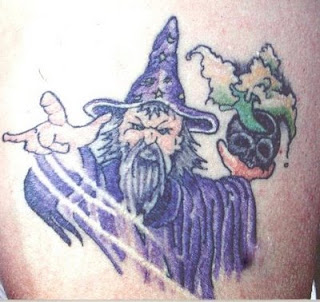First of all, I’d like to apologize to my plush Cthulhu-owning and Miskatonic University shirt-wearing friends for this grumpy and curmudgeonly post. I admit I have an unfair and unhealthy psychological hang-up - my inability to relax and enjoy the recent campy commercialization of H.P. Lovecraft. Instead of resenting me, I hope that you will instead choose to pity me.
I’m a very easy-going fellow when it comes to the never-ending cycle of pop-cultural appropriation, re-interpretation, and commercialization. Mostly I just don’t care. I know what I like, seek it out, and tune out the noise. For instance, I’m okay with the Lord of the Rings movies - even though I think they are a pale shadow of the books, I enjoy them for what they are. I see no benefit in being a snobby purist about these kinds of things. Given this general disposition of mine, I have a hard time understanding why this thriving subculture of campy H.P. Lovecraft knick-knacks drives me
crazy. You know, items like “Cthulhu for President” bumper stickers, “I Escaped Arkham Asylum” t-shirts, Munchkin Cthulhu card games, and, of course, the ubiquitous plush Cthulhus. This stuff should all be really fun and wink-wink, but I just can’t…
can’t… enjoy it.
I have been reading and rereading Lovecraft regularly for over half my life now. I know all of his stories like relatives of mine; their personalities, atmospheres, characters. I don’t really know if this is good or bad. Does it mean my literary tastes haven’t evolved since I was 12? Or does it mean I was lucky to find the good stuff early on? At this point it’s hard to untangle how much of my aesthetic fancy is simply
attracted to Lovecraft vs.
defined by Lovecraft. Whatever the case may be, it all boils down to the fact that some portion of my creative identity is quite intertwined with Lovecraft’s work.
I think this must be the root of my problem. Maybe when I see campy t-shirts having a little fun with Lovecraft it’s akin to strangers making fun of one of my family members. This is particularly stinging because I suspect that the whole Lovecraftian campfest probably began as a late-20th century tendency to mock Lovecraft’s writing style – especially his use of odd and extravagant adjectives (which I love). Read this
2005 New York Times “review” of Lovecraft where the enlightened literary scholar Daniel Handler (a.k.a. Lemony Snicket – awesome credential, huh?) mocks Lovecraft’s style with precious little mercy! I find that this critical view of Lovecraft’s writing style is more widely known than the content of his fiction, a state of affairs which has frustrated me endlessly.
On top of everything, it turns out that many of the plush-Cthulhu type people I’ve chatted up have never actually read Lovecraft (or maybe they read a little and forgot – I don’t know what’s worse). Five or ten years ago I would become excited by seeing Cthulhu bumper stickers. I’d think, “Wow, here is one of those rare folks who appreciates the Golden Era of Weird Tales Magazine! I can’t wait to have a conversation about what Brown Jenkin looks like or what Wilbur Whatley’s ancestors were like!!” (Pathetic, I know.) No longer. In my experience most of these folks know of “Cthulhu” primarily as a pop culture franchise. Maybe they saw one of the movies (
Re-Animator? Argh!) or maybe they played one of the licensed boardgames. Luckily, they all seem know that there is, in fact, a “Cthulhu Book” by H.P. Lovecraft, but I guess that book, whatever it is, is not worth reading for most of them. Easier to wait for the movie...
But, you know, I bear no ill will towards the people who love to cuddle with their plush Cthulhus yet have never taken even a few minutes to read
The Music of Erich Zann. There’s no real reason any of these people should know or care about H.P. Lovecraft, really. I recognize Lovecraft is very weird fiction written in an unusually baroque style that was self consciously archaic even for the 1920s. I also recognize that most people don’t really read fiction anymore anyway. There’s nothing wrong with having a cute little stuffed demon, it’s fun and funny, after all. I should just be thrilled that some aspects of Lovecraft’s fiction have wiggled down fairly deeply into the slime pit of pop culture... And I suppose I am to a degree.
Yes, this problem I have is all my own – a minor twisted tragedy in my life where my obscure literary hero has been mercilessly mocked and ultimately commercialized as a camp icon. I will now cringe in my isolated corner of the blogosphere, with tears streaming down my face, my sweaty hands clutching a small stack of sticky old paperbacks, while the smiling people move on around me cuddling their plush Cthulhu dolls.
On second thought… Maybe if they came out with a plush Yog Sothoth I’d have to get one.




















































